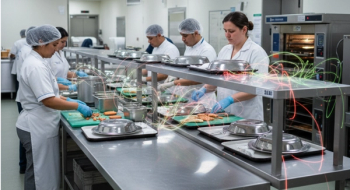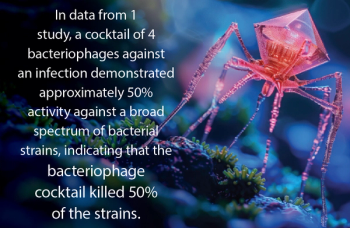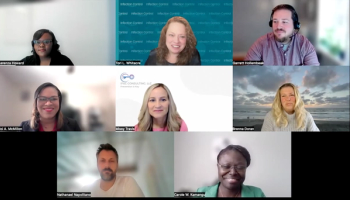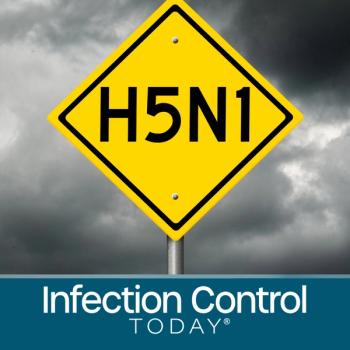
Meet the 2008 ICT Educator of the Year: Barbara DeBaun, RN, MSN, CIC
San Francisco resident Barbara DeBaun, RN, MSN, CIC, has worked in infection prevention and control for more than 30 years. The former director of infection control and patient safety at California Pacific Medical Center (CPMC), DeBaun is currently improvement advisor for Beacon, the Bay Area Patient Safety Collaborative. She is active in professional organizations, has written numerous articles, and lectures nationally and internationally on many infection prevention and control issues and healthcare worker safety. She sat down with ICT to discuss why she loves her work and feels passionate about educating others about proper infection prevention principles and practices.
Q: What do you enjoy about your field and how did you first become involved in infection control?
A: I have been blessed to truly love what I do. I don’t think many people can wake up in the morning and say I’m going to go do something I really like, something I have fun with and most importantly, I feel I can make a difference. It sounds kind of corny but it’s the truth for me. When I was a little girl, I wasn’t thinking I was going to grow up to be an infection control practitioner (ICP), and it wasn’t as if I went looking for it. I was a relatively new graduate and had been working as a nurse for a few years; one day I was called into the chief nurse’s office, convinced I had done something terribly wrong, or why else would she want to see me? She asked me if I would be interested in working in infection control, and of course I was too afraid to say no. I figured, why not? To put this in perspective, this occurred in the mid- to late 1970s and every hospital was just figuring out the fact they better get this infection control position in place because it was required. I absolutely feel like it was a turning point in my life because it gave me the opportunity to enter a career that has been fulfilling, exciting, fun, and immensely gratifying. And I have met so many amazing people along the way.
Q: You entered the field when AIDS was still very much a mystery; how did that shape your work as an ICP?
A: I am a regular speaker at one of the local universities where healthcare professionals speak about their nursing careers, and just a few days ago I was relating the story of how I came to do what I do. The room was filled with 20-year-olds who had never lived in a world without AIDS. I’ll never forget this story: It was 1981, and I was standing at the elevator in the hospital where I worked in New York. I was having a discussion with our infectious disease physician who was telling me he was worried about a young man in the ICU; the doctor had no idea what was going on with his patient, and what kind of disease was affecting him. It turned out to be one of the first cases of AIDS in the country, and we didn’t even know it. I think that was the moment I got hooked on infection control. It was interesting and scary at the same time. When I moved to San Francisco in 1982, I saw a lot of panic over AIDS, and I knew it was a chance to help inform people. At that point, ICPs suddenly were thrust into the limelight and everyone looked to us for information, for assurance, for guidance, and it was a real turning point in my career.
Q: Today, ICPs have so much more to work with in terms of technology-driven tools and information with which to do their jobs. How did ICPs get by in the past?
A: There was no Internet, of course, which is hard to believe now that we can’t live without it. But back then we collected folders full of information and articles that were about 10 years old and not all that useful. So much of our information was dependent upon suspect sources — stories that were in the newspaper and information that perhaps was not accurate, so it was a difficult time of sorting things out. We depended upon groups like the Association for Professionals in Infection Control and Epidemiology (APIC), which held regular meetings in which we could talk with colleagues from other hospitals. We bound together and shared information.
Q: The infection control community has also evolved into a very complex field and a challenging job, hasn’t it?
A: We’re not revenue producers, so people tend to wonder what we do. I’ve always joked with my colleagues that in infection prevention, if you do your job, there’s no news. It’s not like we work for a department where we can point to the money generated by our work. Our work is to ensure that things don’t happen. When things don’t happen, it’s hard to say, “Oh by the way, look what I prevented today! We didn’t have infections because of what we’re doing.” Building the business case for infection prevention is becoming increasingly critical to be able to prove that we are making a difference, we do impact the bottom line, and we do affect patient outcomes, which is more important than anything else.
Q: Are you glad to see ICPs finally being recognized?
A: Yes, and I think anyone in the infection prevention field can make it what they want to make it. They can make it the best possible job they will ever possibly imagine. In the last several years especially, there has been so much more in the press that has put ICPs back into the limelight. Whether we were dealing with SARS, hantavirus, norovirus, C. diff or MRSA, there’s so much more media coverage, and infection prevention is receiving more recognition, which is a good thing. People will say to me, “You’ve done the same thing your whole life, aren’t you bored?” and I think, “are you crazy?” I would love to be bored for just a day, but it’s not going to happen!
Q: In the hysteria over more exotic diseases like avian flu and SARS, are we losing sight of other infectious diseases, and do we forget the basics of infection control?
A: No matter what’s in the press, whether it’s MRSA or SARS, it gets back to the basics. ICPs are the voice of reason; we’re the ones who have to say, OK, if we are worried about MRSA in the workplace, for example, this is a great opportunity to look at the things people are touching frequently. Clean them every now and then — you are going to reduce the incidence of colds and flu, and ultimately make your workplace a safer environment. Use what’s out there, including the hysteria in the news, to educate people. For example, with SARS, there was extensive discussion about wearing masks and no one was talking about handwashing! Let’s be the voice of reason, and let’s reinforce the basics of infection prevention.
Q: You work in a very cosmopolitan city; is that an opportunity for you to encounter new and increased numbers of pathogens and potential outbreaks?
A: There’s a sick thrill that many ICPs get when faced with a new problem — I’m not embarrassed to admit it because that’s what gets us going, that’s what keeps us on our toes. One of the things about infection prevention is you never let them see you scared. You have to be calm when everyone else is freaking out. During an outbreak, you have to be the one armed with the facts based on the epidemiology, because other people will surely see it as Armageddon and we’re all going to die! Because San Francisco is a major port city with an international airport on the Pacific Rim, we see an enormous amount of travelers and cargo coming into town, and we must be on guard. We were watching very closely for the first signs of avian influenza, for example, and that does make for an exciting time professionally. But working in a small or rural place is no less exciting, because there are no boundaries for bacteria. We know that germs can get from one part of the world to another in less than a day. ICPs like to use the “O” word; instead, we like to say we have a “cluster” of something going on. There’s no ICP that hasn’t had some experience in dealing with a higher than normal number. It really brings out everything that we know how to do — confirming the diagnosis, making sure we know what we are dealing with, and really using our epidemiological skills like Sherlock Holmes. It’s what we thrive on. Nobody wants outbreaks, but when they happen, we are prepared to take action. I remember in the old days I would go to the lab, grab a big pile of microbiology slips, and return to my office to sort them in piles. It would take me hours to sort them by units; now, ICPs get electronic lab results sorted by unit or by bug, and it makes getting the case findings so much more efficient. You can then spend your time investigating these things versus finding them.
Q: Are you glad that emphasis has shifted from infection control to infection prevention, and has that created a paradigm shift in how to educate people?
A: It really is quite a dynamic shift in thinking about infections. It’s also a better term for what we’ve always done — I think infection control implies that you’ve got a problem but you’re not going to let it get worse, whereas infection prevention is all about not letting it happen in the first place. I personally think it’s a much more descriptive term of what it is that ICPs do — or IPPs, or whatever we will call ourselves eventually. Prevention is key because that’s what it’s all about. You can control something, like a fire, but it’s best not to let it start in the first place.
Q: What do you consider to be your style of educating?
A: When I was still in a clinical setting, my real joy was the very informal, one-on-one interactions versus more formal classroom learning. I liked standing in the middle of a nurse’s station having a discussion that turns into a teachable moment. All of a sudden, people gather around because they are fascinated by what they are hearing. To me, that is the real joy of infection prevention education. It’s also a joy when a nurse calls and says, “I have a question about such and such.” To be able to respond to their request for information and to see them excited about being educated ... well, that’s what gives me a chill. Telling stories is important, too — making infection prevention real, and using examples. These aren’t just numbers or statistics, these are real people behind these numbers — this is a 3-year-old boy who will never be the same because of this infection that occurred. It’s not about blaming anybody, but making it real and making it stick — I think that is the key to learning. You also have to make learning fun. I think humor is one of the most effective ways to reach people. You can’t take yourself too seriously. Adults don’t learn if they’re bored; they need to have fun with what they are learning.
Q: What are you doing currently for Beacon, the Bay Area Patient Safety Collaborative?
A: I am an improvement advisor with the Beacon collaborative that is funded by the Gordon and Betty Moore Foundation. It consists of 40 hospitals in five of the San Francisco Bay Area counties and focuses on sharing practical ways to accelerate the implementation of proven, evidence- based patient safety interventions that save lives and reduce harm to patients. I am working with 25 of these hospitals as an improvement advisor to facilitate peer-to-peer sharing of best practices. It requires a lot of teaching and a lot of interaction with many people from different facilities, and I love it. If I go to a hospital and I find out they have an incredible program for preventing ventilator-associated pneumonia or central line infections, I encourage them to share their strategies with the rest of the group. It’s amazing that we have been able to bring these hospitals together, essentially competitors that are openly sharing everything for the sake of patient safety, and it’s just remarkable.
Q: What are the other hot issues you are hearing about at these hospitals?
A: The need for transparency and Medicare’s do-not-pay scenarios have gotten the attention of the hospital administrators. They know if a patient gets C. diff or MRSA, the hospital will not get reimbursed if the patient’s stay is extended. It’s come down to the fact that infection prevention departments are going to get more resources, which I think is great. I think finally people will realize, “Hey these things aren’t going to get avoided because we are nice people or we are lucky — we need ICPs to help prevent infections.”
Q: Many ICPs feel strapped for resources and time to do their jobs; what words of wisdom do you have for them?
A: They must not be shy about reaching out to their colleagues, and making sure they participate actively in APIC — that’s an important way for them to realize they are not in this alone. We all try to do so much, and it’s really important to prioritize — what will make a difference and improve the quality of care for patients? With all of the attention being given to infections these days, I would be shocked if it doesn’t result in additional resources for ICPs. I think we need to do a good job of recruiting new, young, fresh minds to this field. When I was speaking to nursing students in the University of San Francisco’s master’s program, many of them wanted to know how they could become ICPs and that was very exciting! Years ago, people would say, “Oh, those infection control people ... what did they do to deserve that job because they just look at charts all day.” That is so not what the job is. We are and should be out there every day, educating people about infection prevention. We should be speaking to the press to make sure they represent the facts accurately, and speaking at schools and being involved in the community. There are so many ways we can demonstrate that we are the experts and have so much knowledge to impart to others. I don’t think a day goes by where there is not something in the media that has something to do with infections — capitalize on that. When I would speak at new-employee orientations, I would always begin with something that was in the press to remind people that this isn’t just hypothetical stuff — this is real life. You can jump on board and get excited about it, or you can pretend it’s not happening. I would like to see people realize that there are so many opportunities to teach others. Reach out to colleagues if you are a sole practitioner in a small facility, and do things that force you to get together with your peers. Work with your local health department — meet the people you talk to on the phone all the time. Get yourself out there, and always keep it real.
Newsletter
Stay prepared and protected with Infection Control Today's newsletter, delivering essential updates, best practices, and expert insights for infection preventionists.






